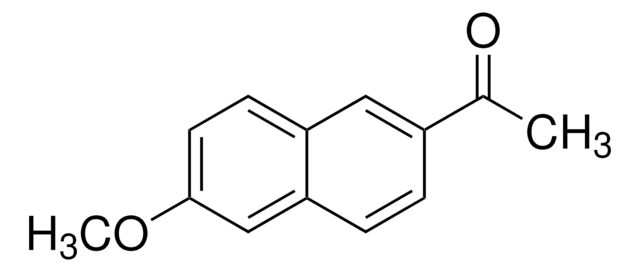1457301
USP
Naproxen
United States Pharmacopeia (USP) Reference Standard
Synonym(s):
(S)-(+)-2-(6-Methoxy-2-naphthyl)propionic acid
About This Item
Recommended Products
grade
pharmaceutical primary standard
API family
naproxen
manufacturer/tradename
USP
technique(s)
HPLC: suitable
gas chromatography (GC): suitable
mp
152-154 °C (lit.)
application(s)
pharmaceutical (small molecule)
format
neat
SMILES string
COc1ccc2cc(ccc2c1)[C@H](C)C(O)=O
InChI
1S/C14H14O3/c1-9(14(15)16)10-3-4-12-8-13(17-2)6-5-11(12)7-10/h3-9H,1-2H3,(H,15,16)/t9-/m0/s1
InChI key
CMWTZPSULFXXJA-VIFPVBQESA-N
Gene Information
human ... PTGS1(5742) , PTGS2(5743)
Looking for similar products? Visit Product Comparison Guide
General description
Application
- Dexamethasone Compounded Oral Suspension
- Naproxen
- Naproxen Compounded Oral Suspension
- Naproxen Delayed-Release Tablets
- Naproxen Oral Suspension
- Naproxen Tablets
- Terazosin Tablets
Biochem/physiol Actions
Analysis Note
Other Notes
related product
signalword
Warning
Hazard Classifications
Acute Tox. 4 Oral - Aquatic Chronic 2 - Eye Irrit. 2 - Repr. 2 - Skin Irrit. 2 - STOT SE 3
target_organs
Respiratory system
Storage Class
11 - Combustible Solids
wgk_germany
WGK 3
Choose from one of the most recent versions:
Certificates of Analysis (COA)
It looks like we've run into a problem, but you can still download Certificates of Analysis from our Documents section.
If you need assistance, please contact Customer Support.
Already Own This Product?
Find documentation for the products that you have recently purchased in the Document Library.
Customers Also Viewed
Our team of scientists has experience in all areas of research including Life Science, Material Science, Chemical Synthesis, Chromatography, Analytical and many others.
Contact Technical Service









